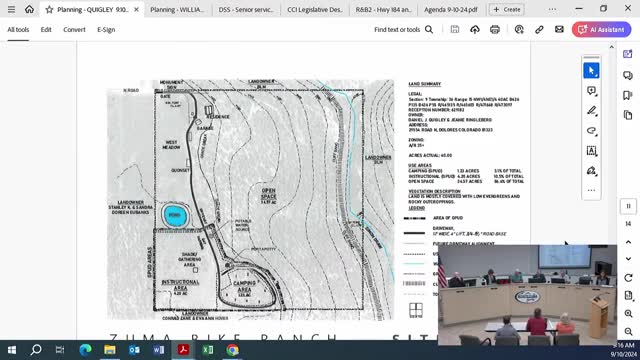Zoning Board Faces Controversy Over Mountain Bike Campground Proposal
September 10, 2024 | Montezuma County, Colorado
This article was created by AI summarizing key points discussed. AI makes mistakes, so for full details and context, please refer to the video of the full meeting. Please report any errors so we can fix them. Report an error »

In a recent government meeting, the proposal for a general plan unit development (PUD) at Zuma Bike Ranch was discussed, focusing on the establishment of a dry camping area with eight campsites. The owner, Mister Quigley, aims to enhance the existing mountain biking instructional facility by allowing camping for participants, with strict regulations including a prohibition on open fires and limitations on vehicle sizes.
The Planning and Zoning Commission recommended the proposal for approval with a 4-1 vote, contingent upon adherence to the application plan. The discussion highlighted the distinction between allowing camping solely for instructional purposes versus opening the site to the general public. If the operation were to expand beyond its current scope, it would require a high-impact permit due to increased traffic and campsite numbers.
Concerns were raised regarding the commercial nature of the proposal, as the property is zoned for agricultural use. Legal opinions indicated that while the PUD allows for mixed-use developments, there is a risk of circumventing zoning regulations by establishing a commercial operation in a primarily agricultural area. The board emphasized the importance of maintaining the integrity of zoning laws to prevent spot zoning, which could lead to commercial encroachments in rural settings.
Despite these concerns, the board acknowledged the potential benefits of the development, particularly in supporting the local mountain biking community and tourism related to nearby attractions like Phil's World. The owner reassured the board that the camping experience would be primitive, adhering to a \"leave no trace\" policy, and emphasized the importance of maintaining good relationships with neighboring properties, all of which reportedly support the initiative.
The meeting concluded without public opposition, and the board members expressed a willingness to consider the proposal, reflecting on previous similar applications that had been approved under comparable circumstances. The decision ultimately hinges on balancing the need for recreational facilities with the preservation of agricultural zoning integrity.
The Planning and Zoning Commission recommended the proposal for approval with a 4-1 vote, contingent upon adherence to the application plan. The discussion highlighted the distinction between allowing camping solely for instructional purposes versus opening the site to the general public. If the operation were to expand beyond its current scope, it would require a high-impact permit due to increased traffic and campsite numbers.
Concerns were raised regarding the commercial nature of the proposal, as the property is zoned for agricultural use. Legal opinions indicated that while the PUD allows for mixed-use developments, there is a risk of circumventing zoning regulations by establishing a commercial operation in a primarily agricultural area. The board emphasized the importance of maintaining the integrity of zoning laws to prevent spot zoning, which could lead to commercial encroachments in rural settings.
Despite these concerns, the board acknowledged the potential benefits of the development, particularly in supporting the local mountain biking community and tourism related to nearby attractions like Phil's World. The owner reassured the board that the camping experience would be primitive, adhering to a \"leave no trace\" policy, and emphasized the importance of maintaining good relationships with neighboring properties, all of which reportedly support the initiative.
The meeting concluded without public opposition, and the board members expressed a willingness to consider the proposal, reflecting on previous similar applications that had been approved under comparable circumstances. The decision ultimately hinges on balancing the need for recreational facilities with the preservation of agricultural zoning integrity.
View full meeting
This article is based on a recent meeting—watch the full video and explore the complete transcript for deeper insights into the discussion.
View full meeting
